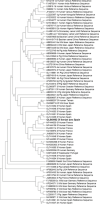Hepatitis E virus in the endangered Iberian lynx (Lynx pardinus)
- PMID: 35690914
- PMCID: PMC9796619
- DOI: 10.1111/tbed.14624
Hepatitis E virus in the endangered Iberian lynx (Lynx pardinus)
Abstract
Hepatitis E virus (HEV) is an emerging zoonotic pathogen in Europe. In the Iberian Peninsula, wild boar (Sus scrofa) is considered the main wildlife reservoir of HEV. This wild ungulate shares habitat and resources with other potential HEV carriers in Iberian Mediterranean ecosystems, although information about the role of such sympatric species in the HEV epidemiological cycle is still very limited. The aims of the present large-scale, long-term study were: (1) to determine the seroprevalence and prevalence of HEV in both free-living and captive populations of the Iberian lynx (Lynx pardinus), the most endangered felid in the world; (2) to determine potential risk factors associated with HEV exposure in this species and (3) to evaluate the dynamics of seropositivity in longitudinally sampled animals during the study period. Between 2010 and 2021, serum samples from 275 Iberian lynxes were collected in free-ranging and captive populations across the Iberian Peninsula. Forty-four of the 275 lynxes were also longitudinally sampled during the study period. A double-antigen sandwich ELISA was used to test for the presence of antibodies against HEV. A subset of seropositive samples was analysed by Western blot (WB) assay to confirm exposure to HEV. In addition, serum, liver and/or faecal samples from 367 individuals were tested for orthohepevirus RNA by RT-PCR. A total of 50 (18.2%; 95% CI: 14.1-23.2) of the 275 animals analysed had anti-HEV antibodies by ELISA. Exposure to HEV was confirmed by WB in most of the ELISA-positive Iberian lynxes analysed. Significantly higher seroprevalence was found in captive (33.6%) compared to free-ranging (7.4%) individuals. Within captive population, the GEE model identified 'age' (senile, adult and subadult) as risk a factor potentially associated with HEV exposure in the Iberian lynx. Thirteen (29.5%) of 44 longitudinally surveyed individuals seroconverted against HEV during the study period. HEV RNA was detected in the faeces of one (1/364; 0.3%; 95% CI: 0.0-0.8) free-ranging adult animal sampled in 2021. Phylogenetic analysis showed that the sequenced strain belongs to HEV-3f subtype and shared a high nucleotide sequence identity (97-99.6%) with human HEV-3f sequences from Spain and France. To the best of the authors' knowledge, this is the first survey study on HEV in the Iberian lynx and the first molecular report of HEV-A infection in free-ranging felines. Our results indicate high exposure to HEV-3 in Iberian lynx populations, particularly those kept in captivity. The serological results suggest widespread but not homogeneous circulation of HEV in Iberian lynx populations. Further studies are required to assess the epidemiological role of this endangered species as a potential spillover host of HEV.
Keywords: HEV-3f; Iberian lynx; epidemiology; hepatitis E; risk factors.
© 2022 The Authors. Transboundary and Emerging Diseases published by Wiley-VCH GmbH.
Conflict of interest statement
None of the authors of this study has a financial or personal relationship with other people or organizations that could inappropriately influence or bias the content of the paper.
Figures



Similar articles
-
Monitoring of Leishmania infantum exposure in the Iberian lynx (Lynx pardinus).Prev Vet Med. 2025 Jan;234:106366. doi: 10.1016/j.prevetmed.2024.106366. Epub 2024 Oct 31. Prev Vet Med. 2025. PMID: 39527902
-
Endemic and widespread exposure to Sarcoptes scabiei in the threatened Iberian lynx (Lynx pardinus).Prev Vet Med. 2025 Sep;242:106585. doi: 10.1016/j.prevetmed.2025.106585. Epub 2025 May 27. Prev Vet Med. 2025. PMID: 40446426
-
Monitoring of Coxiella burnetii in the Iberian lynx (Lynx pardinus).Prev Vet Med. 2024 Nov;232:106330. doi: 10.1016/j.prevetmed.2024.106330. Epub 2024 Aug 30. Prev Vet Med. 2024. PMID: 39216329
-
Feline leukemia virus infection: a threat for the survival of the critically endangered Iberian lynx (Lynx pardinus).Vet Immunol Immunopathol. 2010 Mar 15;134(1-2):61-7. doi: 10.1016/j.vetimm.2009.10.010. Epub 2009 Oct 14. Vet Immunol Immunopathol. 2010. PMID: 19896221 Free PMC article. Review.
-
Dietary profiles of wild carnivores and Blastocystis occurrence: The case of the endangered Iberian lynx (Lynx pardinus) and systematic review.Res Vet Sci. 2025 Mar;184:105518. doi: 10.1016/j.rvsc.2024.105518. Epub 2024 Dec 26. Res Vet Sci. 2025. PMID: 39765196
Cited by
-
Puzzles for Hepatitis E Virus.Adv Exp Med Biol. 2023;1417:247-256. doi: 10.1007/978-981-99-1304-6_17. Adv Exp Med Biol. 2023. PMID: 37223871
-
A retrospective serosurvey of selected pathogens in red foxes (Vulpes vulpes) in the Tuscany region, Italy.Acta Vet Scand. 2023 Jul 14;65(1):35. doi: 10.1186/s13028-023-00699-6. Acta Vet Scand. 2023. PMID: 37452391 Free PMC article.
-
Monitoring of Hepatitis E Virus in Wild Lagomorphs in Spanish Mediterranean Ecosystems.Transbound Emerg Dis. 2023 Apr 19;2023:7947220. doi: 10.1155/2023/7947220. eCollection 2023. Transbound Emerg Dis. 2023. PMID: 40303740 Free PMC article.
-
Hepatitis E Virus in the Iberian Peninsula: A Systematic Review.Food Environ Virol. 2023 Sep;15(3):193-211. doi: 10.1007/s12560-023-09560-5. Epub 2023 Jul 11. Food Environ Virol. 2023. PMID: 37434079 Free PMC article.
-
Serological survey on Hepatitis E virus in Namibian dogs, cats, horses, and donkeys.Front Vet Sci. 2024 Jul 18;11:1422001. doi: 10.3389/fvets.2024.1422001. eCollection 2024. Front Vet Sci. 2024. PMID: 39091395 Free PMC article.
References
-
- Caballero‐Gómez, J. , García‐Bocanegra, I. , Gómez‐Guillamón, F. , Camacho‐Sillero, L. , Zorrilla, I. , Lopez‐Lopez, P. , Cano‐Terriza, D. , Jiménez‐Ruiz, S. , Frias, M. , & Rivero‐Juarez, A. (2020). Absence of Hepatitis E virus circulation in wild rabbits (Oryctolagus cuniculus) and Iberian hares (Lepus granatensis) in Mediterranean ecosystems in Spain. Transboundary and Emerging Diseases, 67(4), 1422–1427. 10.1111/tbed.13478 - DOI - PubMed
MeSH terms
Substances
Grants and funding
- RD12/0017/0012/Ministerio de Sanidad
- PI19/00864/Fundación para la Investigación en Salud (FIS) del Instituto Carlos III
- PI21/00793/Fundación para la Investigación en Salud (FIS) del Instituto Carlos III
- FPU17/01319/Spanish Ministry of Science, Innovation and Universities
- CP18/00111/Miguel Servet Research Contract by the Spanish Ministry of Science, Innovation and Universities

